
Overland Tech and Travel
Advice from the world's
most experienced overlanders
tests, reviews, opinion, and more
iPhone LifeProof Case, part 1
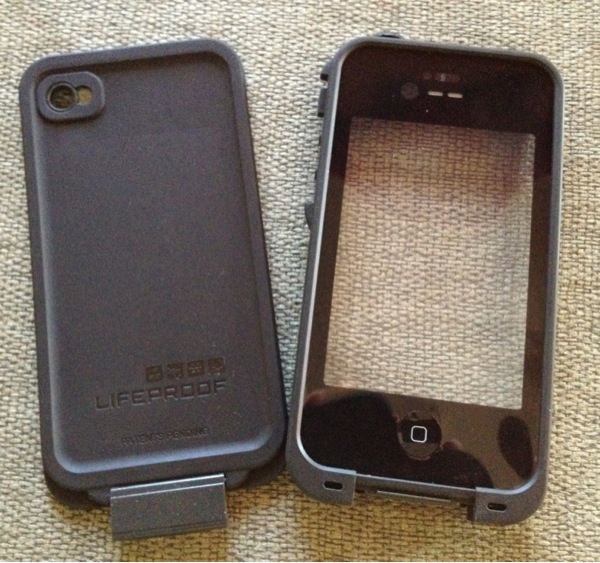
For more and more people, our phones are not just devices with which to phone home, they are also our primary GPS, pocket camera, video recorder, notepad, music player, book reader, dictionary, translation tool, and complete mobile office. In fact, I am writing this review on my iPhone 4S.
With so much at stake, especially while traveling, protection is key. Not only are these pricey electronic gadgets averse to water and fearful of heights (i.e. made from slabs of glass), they are for the most part uninsurable.
At the Outdoor Retailer show in August I selected a few of the newest crop of rugged iPhone cases to test during our trip to the UK and Kenya. Plenty of rain in one place and dust in the other; I figured on some perfect testing conditions.
First up is the LifeProof Case ($80, Lifeproof.com). I found it highly attractive because it is not only fully waterproof to 2 meters, totally dustproof, and shockproof to 2 meters (full MIL-STD-810F-516.5 = 2 meters/6.6ft drop on all surfaces and edges), it is so streamlined it hardly changes the profile of the phone. It adds 1.5mm to each side and weighs less than an ounce (28g).
But wait there's more: the covers for the camera lenses are double AR-coated optical glass and the speaker covers are gas-permeable waterproof membranes (I believe Gore-Tex but I haven't been able to verify that while on the road).
So here are the first impressions.
- Passed the "at-home" wateproof test as specified in the instructions (to seal, sans iPhone, and submerge in water, weighted, for at least an hour)
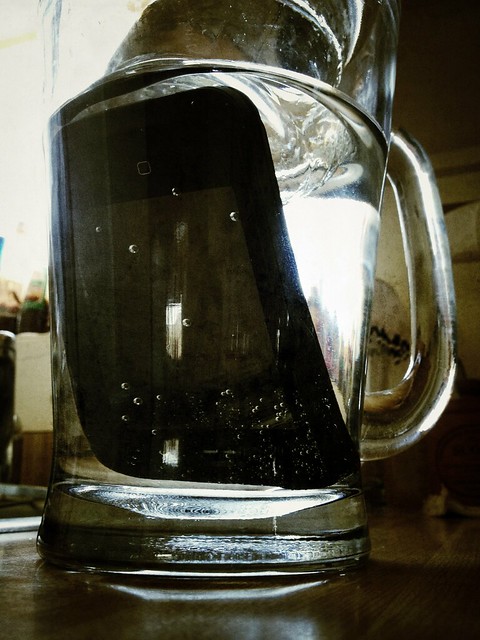
During (above) and after (below) the dunk test. No water in the case or at the gaskets.

- The fittings snap together very tightly. Unlike the Otterbox case, they actually are very tough to put together and the company includes a long list of "must-do" actions to ensure the case is sealed properly. While fussy at first, you soon realize it's serious protection for an expensive gadget. However, after sealing in my iPhone 4S, the first thing I noticed was that the screen protector was warped and stood proud of the screen by about 1mm or more. This made it nearly impossible to use as anything but just a "hello" phone. Texting or manipulating photos (which I do a lot) was just silly—the fingers don't meet the screen and there is no contact, so nothing happens.
I searched forums and found this to be an intermitent problem, so after a call to the rep the company agreed to send a new one. This one fit very, very snugly and the screen protector very close (if not 100%) to the screen, so I found it easy to use, if not perfect. The Otterbox fits flat to the screen with no warping, but it's not 100% waterproof to 2m.
 Extensive instructions and warnings accompany the LifeProof case.
Extensive instructions and warnings accompany the LifeProof case.
- The only charger you can use is the factory Apple charger / cord. My spiffy retractable cord won't work with it, nor will it work with my Griffin iTrip.
- To use headphones you must use the adaptor (so it seals) or use Bluetooth.
After 10 days on the road taking photos, posting on Flickr (see Flickr.com/photos/conserventures), Instagram, Facebook, Twitter, and here, I can say I really like this case. However, I admit to an unfair gripe. The replacement test model came in blue rather than the original (and my favorite) black. I hate blue. I just do. There's no logic. So when our friend Duncan in Scotland admired the blue case, and showed me his new black LifeProof case, I jumped at the chance to switch. Interestingly, the black case does not fit as well as that blue one, but it fits better than the first one I had. So lesson is: you might have to try multiple models to get the best fit.
So far the screen has not scratched. I have not dropped it, but I've used it in foggy spitting rain in Scotland, and it sat in a wet pocket for most of a half-day walk round a village. I noticed a little bit of fogging when we went from cold/wet to warm environments but it cleared quickly.
Next up: we're flying to Kenya, where we will fully test the LifeProof in the dusty, dry Rift Valley.
Outdoor Retailer, day 3—security
Securing our gear (or your wallet and passport) is always top on our mind, whether locking up to go on a hike at Grand Canyon or shopping for produce in Congo. Here are few security accessories we spotted at the show:
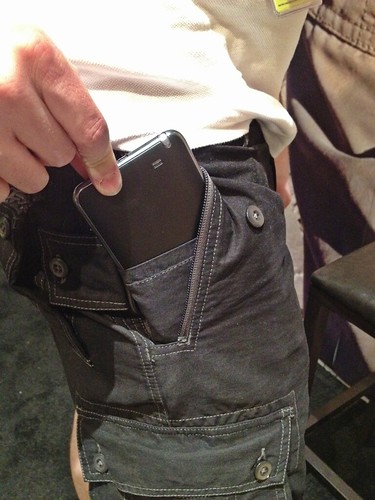 P^cubed pants (pickpocket-proof) have multiple layers of security, from super tough fabric and thread to triple layer pocket openings. From Clothing Arts.
P^cubed pants (pickpocket-proof) have multiple layers of security, from super tough fabric and thread to triple layer pocket openings. From Clothing Arts.
 Banner at the Clothing Arts booth explaining the P^cubed pants.
Banner at the Clothing Arts booth explaining the P^cubed pants.
 TravelOn's security purses look like a good alternative if you need to carry a shoulder bag. Each has a steel-wire net incorporated, and slash-proof strap. A cross-body carry is recommended to avoid snatch-and-run, obviously.
TravelOn's security purses look like a good alternative if you need to carry a shoulder bag. Each has a steel-wire net incorporated, and slash-proof strap. A cross-body carry is recommended to avoid snatch-and-run, obviously.
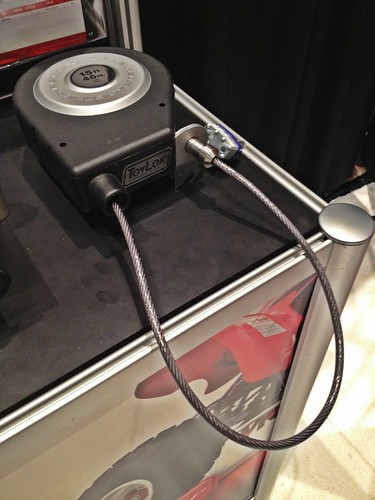 ToyLok's retractable-cable steel lock can be secured to your vehicle and easily deployed to lock bikes or boats. They are considering a smaller version for motorcycles.
ToyLok's retractable-cable steel lock can be secured to your vehicle and easily deployed to lock bikes or boats. They are considering a smaller version for motorcycles.
Outdoor Retailer, day 1
Overland Tech and Travel arrived at Outdoor Retailer in sunny Salt Lake City this afternoon. We managed to visit a couple dozen booths before the happy hours began. Over the next three days we will be reporting on new gear as well as just cool stuff. Follow our Flickr Outdoor Retailer set as well (http://www.flickr.com/photos/conserventures/sets/72157630877676310/with/7701752420/).
Here's a preview:

BioLite stove: burns wood (think Kelly kettle on steroids) and generates electricity for charging phones and laptops. Brilliant. A prototype heat-concentrating cooktop, below, was also on display. BioLite.com
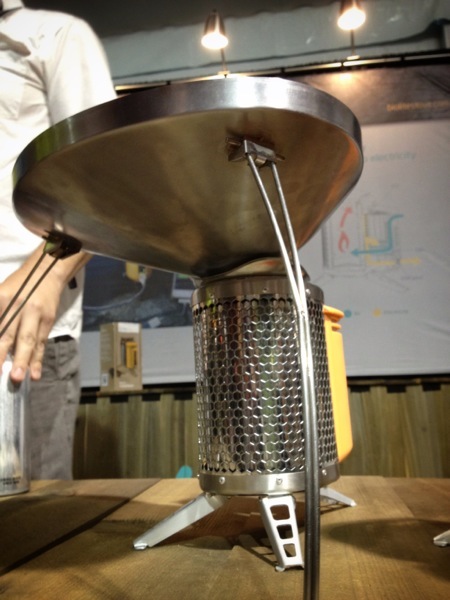
Stealth gray KTM 950 Adventure parked in the shade outside the south entrance.

Zippo's beautifully crafted brushed "aluminum" Jeep JK Wrangler, with embossed doors, flame grille, and lighter rear rack box.
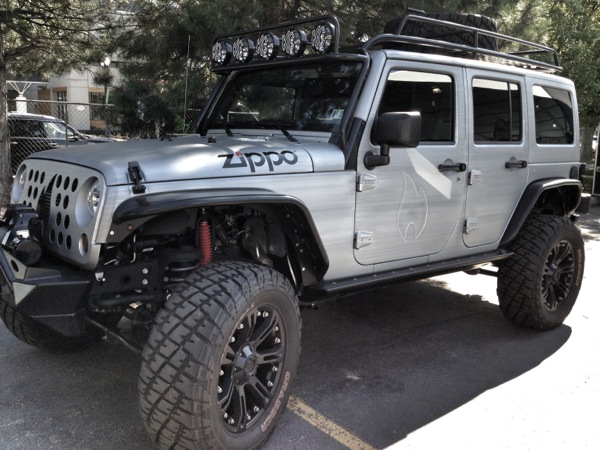
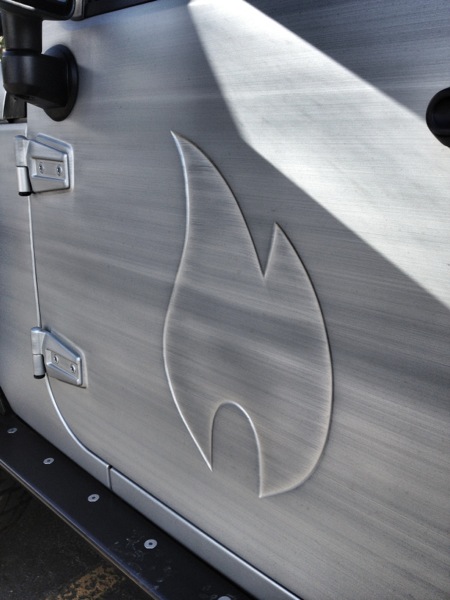
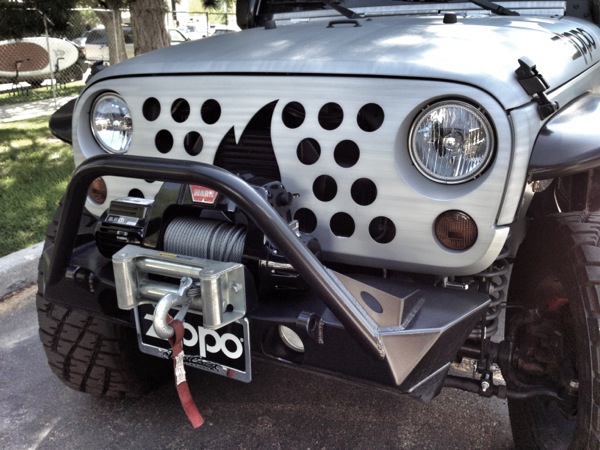
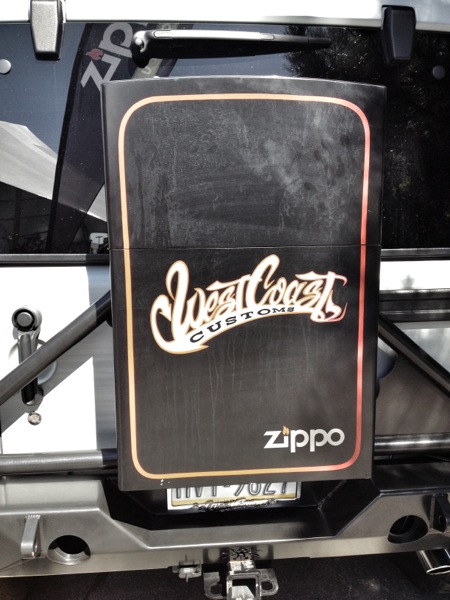
Dahon bicycles fold up into small packages, perfect for overlanding around the globe.
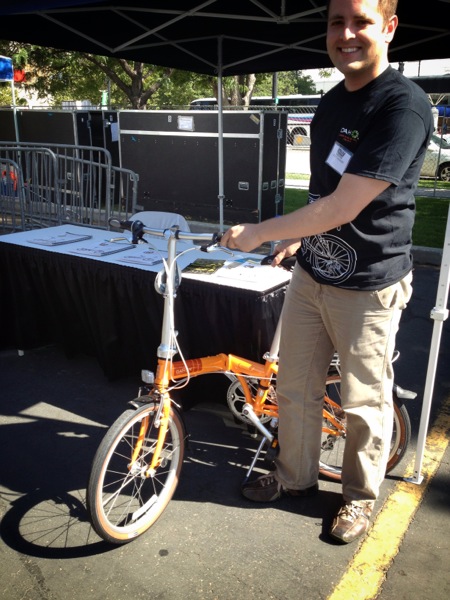
Lifeproof's incredibly slender iPhone case is nevertheless shock-resistant (two-meter drop), dustproof, and waterproof to a depth of six feet - which means your phone will now easily survive being dropped in the toilet.
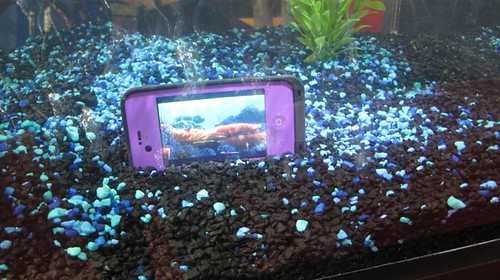
GoPro's display featured this spectacular replica of a legendary Rothmans Paris-Dakar Porsche 911 SC RS.

Insuring an older vehicle for overlanding outside the U.S.

Like you, I have an older vehicle that I've put a newer diesel engine in, and am hesitant to drive to Mexico without being able to get full coverage (ideally, an agreed amount policy). It seems that most companies that sell Mexican auto insurance (e.g., Sanborn's) won't provide full coverage for a vehicle older than 10 years (for some companies, 15). I'd like to drive my Land Rover to Mexico, but not if I can't get full coverage for it (not just liability). Any suggestions or advice (other than buy a cheap, newer vehicle)? Thanks.
We sold our FJ60 recently and are looking for a diesel pickup on which we'll put a Four Wheel Camper, so perhaps if we have Tom Hanagan at FWC plumb a toilet and make it a pass-through (which we'd like), we can qualify for better insurance.
Touring tip: When it's tool time on the road
 Published with the permission of RoadRUNNER Motorcycle Touring & Travel Magazine for Overland Tech & Travel / Overland Expo only. Not for sale or distribution.
Published with the permission of RoadRUNNER Motorcycle Touring & Travel Magazine for Overland Tech & Travel / Overland Expo only. Not for sale or distribution. If you’re like most adventure motorcyclists, you don’t want any type of mechanical problem to deal with during a motorcycle tour. And, of course, the best way to keep that from happening is a heavy dose of preventative medicine before your bike ever leaves the garage. But unforeseen mechanical malfunctions can and do happen out on the road. So, taking selected tools with you and knowing how to use them are sensible precautions for any touring rider.
If you’re like most adventure motorcyclists, you don’t want any type of mechanical problem to deal with during a motorcycle tour. And, of course, the best way to keep that from happening is a heavy dose of preventative medicine before your bike ever leaves the garage. But unforeseen mechanical malfunctions can and do happen out on the road. So, taking selected tools with you and knowing how to use them are sensible precautions for any touring rider.
Key Assumptions: If you ask 10 different riders for their list of necessary tools to have along, you may get 10 different lists. That’s probably because of the assumptions each person is making in several key areas:
- Length of Trip: The longer you expect to be on the road the more likely it is that something on the bike will need repair. If your trip involves going around the globe, then many more tools and spare parts will be needed than for a weekend jaunt to the mountains.
- Type of Bike & Riding: All other things being equal, dual-sport riding and adventure touring are more likely to result in something coming loose or a bike going down than while street riding.
- Riding Environment: Riding in remote locations usually requires riders to be more self-reliant in fixing whatever needs repairing.
- Number of Riders in the Group: The solitary rider must carry all of the tools and spare parts he or she might need. In group riding situations the load can be spread amongst the riders.
- Mechanical Expertise of Rider(s): There’s no point in carrying a lot of tools and spare parts if you don’t know how to use them to make the repairs. Riders traveling long distances in remote areas, however, should have the requisite mechanical expertise and equipment to repair most any type of mechanical malfunction.
 Published with the permission of RoadRUNNER Motorcycle Touring & Travel Magazine for Overland Tech & Travel / Overland Expo only. Not for sale or distribution.
Published with the permission of RoadRUNNER Motorcycle Touring & Travel Magazine for Overland Tech & Travel / Overland Expo only. Not for sale or distribution. If you’re like most adventure motorcyclists, you don’t want any type of mechanical problem to deal with during a motorcycle tour. And, of course, the best way to keep that from happening is a heavy dose of preventative medicine before your bike ever leaves the garage. But unforeseen mechanical malfunctions can and do happen out on the road. So, taking selected tools with you and knowing how to use them are sensible precautions for any touring rider.
If you’re like most adventure motorcyclists, you don’t want any type of mechanical problem to deal with during a motorcycle tour. And, of course, the best way to keep that from happening is a heavy dose of preventative medicine before your bike ever leaves the garage. But unforeseen mechanical malfunctions can and do happen out on the road. So, taking selected tools with you and knowing how to use them are sensible precautions for any touring rider.
Key Assumptions: If you ask 10 different riders for their list of necessary tools to have along, you may get 10 different lists. That’s probably because of the assumptions each person is making in several key areas:
- Length of Trip: The longer you expect to be on the road the more likely it is that something on the bike will need repair. If your trip involves going around the globe, then many more tools and spare parts will be needed than for a weekend jaunt to the mountains.
- Type of Bike & Riding: All other things being equal, dual-sport riding and adventure touring are more likely to result in something coming loose or a bike going down than while street riding.
- Riding Environment: Riding in remote locations usually requires riders to be more self-reliant in fixing whatever needs repairing.
- Number of Riders in the Group: The solitary rider must carry all of the tools and spare parts he or she might need. In group riding situations the load can be spread amongst the riders.
- Mechanical Expertise of Rider(s): There’s no point in carrying a lot of tools and spare parts if you don’t know how to use them to make the repairs. Riders traveling long distances in remote areas, however, should have the requisite mechanical expertise and equipment to repair most any type of mechanical malfunction.
Most Common Malfunctions on the Road
It behooves all riders to have the necessary tools and skills to fix the motorcycle malfunctions that are most likely to occur on tour:
- Flat Tire: For tubeless tires, there are a number of kits available in the marketplace that enable riders to perform a temporary repair, without removing the tire from the bike. Besides the CO2 cartridges that come with these kits, it’s a good idea to have a small compressor to ensure that the re-inflated tire has sufficient pressure for safe riding. (You’ll need a tire pressure gauge to know for sure.) However, riders should have a professional technician repair or replace the tire as soon as possible.
For tube-type tires, the repair process is more involved and requires more tools. (Helpful hint: Even if a tire is marked “tubeless” on the outside, if it’s mounted on a spoke wheel, a tube will be required on the inside.) The wheel and tire must be removed from the bike, so the necessary wrenches should be on board for both the front and rear axles. Tire irons and a bead buster will be needed to remove the tube for repair or replacement.
- Electrical Malfunction: The most common types of electrical problems are blown fuses and burned out light bulbs. So, it’s important to know where the fuses are located on the bike and to have spares with the correct wattage. Also, it’s a good idea to carry extra bulbs for the headlight, taillight and turn signals, and to have the correct tools and expertise to replace them.
- Broken Cable(s) and Levers(s): Broken cables are a potential issue only on bikes with a manual clutch (i.e., non-hydraulic) or drum brakes. In these situations, carry an extra cable(s) already zip-tied in place with the one in use. This will dramatically reduce repair time if a cable breaks.
A broken clutch or brake lever, usually caused by a fall, can be a big problem on the road. Although the risk of a broken brake lever is somewhat hedged by the fact that there are two of them, there is only one clutch lever and it’s pretty hard to ride a motorcycle without the benefit of a clutch. Consequently, taking extra levers is a good insurance policy.
- Fouled Spark Plug(s): It’s always a good idea to have extra spark plugs, which have been pre-gapped, along on your trips. They don’t take up much space and can make the difference of whether you're stranded or not. Obviously, the proper wrenches will be needed to replace them.
- Low Motor Oil: If your bike has a history of using oil, it makes a lot of sense to take along a quart of motorcycle oil, which might otherwise be difficult to find on a Sunday, Monday or Holiday.
- Broken Bodywork: Sometimes a spill can leave cracked and loose body parts, which can make the motorcycle unsafe to ride. A roll of duct tape can often do wonders in these situations.
The above list is not an exhaustive one, but it does represent the type of malfunctions that could occur on a trip of several weeks.
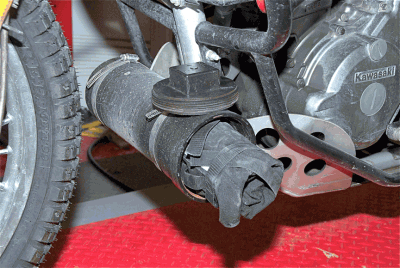 Customizing Your Toolkit
Customizing Your Toolkit
Unfortunately, the tool kits that come with bikes are often of inferior quality. You don’t want a wrench breaking or rounding off a nut when you’re relying on it to get you out of a predicament. Consequently, I’m an advocate of building a customized toolkit that’s designed around the type of repairs you may have to perform on the road. Based on the key assumptions about your touring plans and the types of repairs that are likely to occur, acquire the specific, high quality sockets, ratchets, screwdrivers and other wrenches that are needed to perform these tasks. It’s OK to use items from the manufacturers toolkit if they’re of sufficient quality. To make sure you have what’s needed, use your tool kit while still at home to remove the wheels, change a spark plug, replace a light bulb, etc.
I found that the customized tool kit for my dual-sport bike would no longer fit under the seat, so I fashioned a separate container out of PVC pipe and mounted it on the skid plate. So far I’ve been able to make any needed repairs on the road - but the best tools to have along are still a cell phone and a credit card.
Published with the permission of RoadRUNNER Motorcycle Touring & Travel Magazine for Overland Tech & Travel / Overland Expo only. Not for sale or distribution.
Vehicle rentals in New Zealand?
My wife and I are headed to New Zealand in March and I wanted to see if you knew of anybody down there who did vehicle rentals? We are looking at renting a pop-top camper van to spend our 2 weeks traveling around the south island. Any leads would be helpful! Thank you for your help.
~ Beau Johnston (www.LivingOverland.com Gourmet Cooking * Travel * 4WD) via email
10 Great Last-minute Christmas Suggestions
Whether your preferred mode is motorcycle, truck, bicycle, or foot, Overland Tech & Travel editor Jonathan Hanson offers up great last-minute gift suggestions for the overlanders on your list—or a treat for yourself.
 Fenix E11 LED microlight ($27)
Fenix E11 LED microlight ($27)
I remember when I thought a halogen flashlight that produced 70 lumens from two expensive lithium batteries (for one hour) was hot stuff. The E11 puts out 105 lumens for almost two hours from a single AA battery—or a walking/reading-level 32 lumens for eight hours on low. Astonishing. Headed to the developing world? Take several—they make genuinely useful trade items or gifts. Fenix
Whether your preferred mode is motorcycle, truck, bicycle, or foot, Overland Tech & Travel editor Jonathan Hanson offers up great last-minute gift suggestions for the overlanders on your list—or a treat for yourself.
 Fenix E11 LED microlight ($27)
Fenix E11 LED microlight ($27)
I remember when I thought a halogen flashlight that produced 70 lumens from two expensive lithium batteries (for one hour) was hot stuff. The E11 puts out 105 lumens for almost two hours from a single AA battery—or a walking/reading-level 32 lumens for eight hours on low. Astonishing. Headed to the developing world? Take several—they make genuinely useful trade items or gifts. Fenix
 Hasyun merino wool underwear (from $43)
Hasyun merino wool underwear (from $43)
I just tried out this very affordable base layer system in 5º Fahrenheit blizzard conditions on a strenuous elk hunt. Verdict: Scrumptious. Wait, I didn’t mean to write that. What I meant was, “Excellent.” Hasyun underwear—made in Turkey since 1952—uses Woolmark accredited extra-fine merino wool from New Zealand. It’s sensuously soft and warm for its weight, machine-washable, and won’t retain odors like that nasty polyester stuff. The small/medium size in both top and bottom fit my 150-pound, 5’9” frame perfectly. Available in both men’s and women’s, imported by a little company that also sells, um, kid’s bicycles. Go figure. Hasyun
 MSR Titan titanium pot ($60)
MSR Titan titanium pot ($60)
Pot, kettle, bowl, mug, scoop—MSR’s brilliant 4.2-ounce Titan pot does it all. It’s the only cook kit you need for a solo motorcycle tour, or a compact coffee-making system for your 4x4. An MSR Pocket Rocket stove and fuel canister ride neatly inside. I’d like to have one of these stashed in every vehicle we own. It should be the official MoMA ultralight cooking pot. Simply perfect.MSR Titan
 Vintage pocket compass ($60-$140)
Vintage pocket compass ($60-$140)
You can employ a vintage pocket compass two ways. Produce it with a flourish from a vest pocket, leashed on a leather cord or—better—a silver chain, and flip open the lid to consult it as Selous might have on his way to the Rufiji River. Or, glance at it surreptitiously, then point to the horizon and say sagely, “That should be north.” Either way your companions will be impressed. I carry my WWII-era Wittnauer version everywhere—it’s especially handy for remaining oriented south of the Equator, where the sun always seems to be in the wrong place. This young woman (Kornelia Takacs, who also wrote the book Compass Chronicles), has a wonderful selection: Vintage compasses
 Helle Temagami ($170)
Helle Temagami ($170)
Everyone should own at least one really good sheath knife—and if it happens to be beautiful as well, all the better. The Temagami (say teh-mah-gah-mee) from Norway is both. A hand-filling, oiled curly birch handle surrounds a superb laminated steel blade—two resilient 18-8 stainless outer layers sandwiching a high-carbon cutting edge. Like all Helle knives, the Temagami comes razor sharp, in a leather sheath that works equally well for right- or left-handers. I’ve included two suppliers: Feathered Friends, who also make some of the best down sleeping bags in the world, and the delightful Ragweed Forge, which you should visit anyway. Feathered Friends Ragweed Forge
 Overland Expo 2012 Gift Certificate ($265)
Overland Expo 2012 Gift Certificate ($265)
Okay, it’s our own event, but after all, think of what you get: Three days of classes & programs (over 80 to choose from); driving instruction from Camel Trophy team members in your own vehicle or a new Land Rover; an all-new Camel Trophy Overland Skills Area where you might, say, learn how to build a bridge to get your 110 across a washed-out ravine; motorcycle instruction from RawHyde Adventures, the official BMW training partner; over 120 vendors & exhibitors of high-quality overlanding products & services; the Adventure Travel Film Festival; happy hours; and a barbecue to wrap it all up. We’ll do up a custom e-Card or printed card. Find out why people come again and again. Overland Expo
 Cerberus (from $499)
Cerberus (from $499)
The era of one-way “I’m okay” or “Help!” global messaging is over. The Cerberus device twins with your smartphone to allow two-way text messaging from anywhere on earth. If a cell network is not available, Cerberus automatically switches to the Iridium satellite network. You can send up to 160-character messages, and receive up to 1600-character messages. In an emergency it allows detailed two-way communication with a 24/7 command center. You can also drop breadcrumbs, and receive customized regional weather and geo-political alerts. We’ll be testing a unit in the Egyptian desert early next year, so that last feature might come in handy. Cerberus
 ARB CKMTA12 air compressor ($540)
ARB CKMTA12 air compressor ($540)
For years, owners of vehicles equipped with ARB’s legendary diff locks have been abusing the tiny little compressors usually supplied to activate them, by adding a connector for filling tires. Surprisingly, they seem to hold up to this quite well, but the process is glacial and the compressors can reach glow-in-the-dark temperatures. The company’s new twin-cylinder compressor will still activate lockers, but its tire-filling and air-tool-operating capacity is in a different universe. It’s fully up to the job of serving as a hard-mounted vehicle-wide air-supply system, with a stout 100-percent duty cycle. (But, really, couldn’t they have just called it the ARB Twin-cylinder Compressor?) ARB
 Goal Zero Sherpa 120 Adventure Kit ($670)
Goal Zero Sherpa 120 Adventure Kit ($670)
Never run out of power again for your laptop, tablet, or phone, with Goal Zero’s 120-watt-hour power pack (AKA lithium iron phosphate battery) and 27-watt folding solar panel—small enough to pack into your panniers. You can also charge the power pack from a wall outlet or cigarette lighter. What impresses me most about Goal Zero is the foolproof plug-and-play nature of their systems, any of which can be effortlessly augmented with additional panels and batteries (or a 120-volt AC inverter). Goal Zero

La Peregrina Natural Pearl Necklace ($3,000,000)
Just seeing if Jonathan is paying attention. (Elizabeth Taylor’s jewelry collection is up for auction at Christie’s; a nice little trinket, this, though not suitable for overlanding in all countries). Christie’s
Review: Desert Travels by Chris Scott, Kindle edition
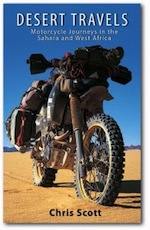
Times have changed when Chris Scott offers a book as a Kindle edition.
It’s not as though the desert travel veteran is un-tech-savy—his authoritative Sahara Overland Forum has been on the Web for what seems like eons. But Chris’s participation in threads there always had sort of a message-from-the-wilderness mystery to it—one imagined him typing on a gritty Panasonic ToughBook from the top of a sand dune, sending the signal via satellite using a generator powered by a camel harnessed to plod in circles, or maybe hooked up to the rear wheel of a knackered Yamaha XT500.
However, the advent of a Kindle edition of his Desert Travels means he must have snuck back to his flat in London for at least long enough to arrange the appropriate technology transfer. In any case, for the price of a cup of coffee ($2.99) you can now have the book downloaded to your Kindle, or a device that can read Kindle books (such as an iPad).
Desert Travels covers some of Chris’s earliest explorations in the Sahara, beginning with his disastrous initial foray and precipitous retreat on an XT500, ending with a fractious ride alongside a pseudonymed companion from Algeria to Mauritania, and centered around a foray into vehicle-supported (via a dodgy 101 Land Rover) guided motorcycle trips, on which “five set off . . . only one came back riding.” This period in the 1980s, just before the nomad rebellions began to make travel in the central Sahara, and Algeria in particular, hazardous in places for foreigners, is what Chris refers to as the Golden Age of Saharan Exploration, when anyone with the experience and/or commitment could undertake truly epic trans-national journeys across an area the size of the United States.

Times have changed when Chris Scott offers a book as a Kindle edition.
It’s not as though the desert travel veteran is un-tech-savy—his authoritative Sahara Overland Forum has been on the Web for what seems like eons. But Chris’s participation in threads there always had sort of a message-from-the-wilderness mystery to it—one imagined him typing on a gritty Panasonic ToughBook from the top of a sand dune, sending the signal via satellite using a generator powered by a camel harnessed to plod in circles, or maybe hooked up to the rear wheel of a knackered Yamaha XT500.
However, the advent of a Kindle edition of his Desert Travels means he must have snuck back to his flat in London for at least long enough to arrange the appropriate technology transfer. In any case, for the price of a cup of coffee ($2.99) you can now have the book downloaded to your Kindle, or a device that can read Kindle books (such as an iPad).
Desert Travels covers some of Chris’s earliest explorations in the Sahara, beginning with his disastrous initial foray and precipitous retreat on an XT500, ending with a fractious ride alongside a pseudonymed companion from Algeria to Mauritania, and centered around a foray into vehicle-supported (via a dodgy 101 Land Rover) guided motorcycle trips, on which “five set off . . . only one came back riding.” This period in the 1980s, just before the nomad rebellions began to make travel in the central Sahara, and Algeria in particular, hazardous in places for foreigners, is what Chris refers to as the Golden Age of Saharan Exploration, when anyone with the experience and/or commitment could undertake truly epic trans-national journeys across an area the size of the United States.
Of course, every explorer since Mungo Park has felt he participated in “The Golden Age of Saharan Exploration,” but in Chris’s case he might have a point. Especially given recently resurgent violence toward tourists in Mali, the days when all one needed to worry about in the Sahara were minor risks such as dying of thirst or heat stroke are, at least temporarily, over.
 One of our Overland Tech & Travel Experts, Sahara expert Chris Scott is also a VIP presenter at Overland Expo each year. Chris is as humble and approachable in person as he is in print, a rare thing for someone with his breadth of experience.Any first-person travelogue runs the risk of self-glorification, or at least self-indulgence—unless it’s written by Chris Scott (or his Saharan compatriot Tom Sheppard). Chris is so modest, the cover of the print edition of Desert Travels shows a motorcycle, period. Nary a sign of the author posing in front and looking off into the distance with steely-eyed determination. The self-effacing attitude pervades the book, and renders it not only insightful but hilarious. There’s one extensive but interesting diversion into the history of the tragicomic Flatters expedition of 1880—it’s almost as if Chris included it to say to the reader, So, just in case you’ve decided I’m inept . . .
One of our Overland Tech & Travel Experts, Sahara expert Chris Scott is also a VIP presenter at Overland Expo each year. Chris is as humble and approachable in person as he is in print, a rare thing for someone with his breadth of experience.Any first-person travelogue runs the risk of self-glorification, or at least self-indulgence—unless it’s written by Chris Scott (or his Saharan compatriot Tom Sheppard). Chris is so modest, the cover of the print edition of Desert Travels shows a motorcycle, period. Nary a sign of the author posing in front and looking off into the distance with steely-eyed determination. The self-effacing attitude pervades the book, and renders it not only insightful but hilarious. There’s one extensive but interesting diversion into the history of the tragicomic Flatters expedition of 1880—it’s almost as if Chris included it to say to the reader, So, just in case you’ve decided I’m inept . . .
No one even close to inept could have survived 30 years of Saharan exploration into some of the most remote regions of the desert, frequently solo. Trust me, for three bucks you’ll get a lot more enjoyment from this book than you will from a cup of Pike Place Roast. Find it here: Desert Travels
Hint: When using “Search,” if nothing comes up, reload the page, this usually works. Also, our “Comment” button is on strike thanks to Squarespace, which is proving to be difficult to use! Please email me with comments!
Overland Tech & Travel brings you in-depth overland equipment tests, reviews, news, travel tips, & stories from the best overlanding experts on the planet. Follow or subscribe (below) to keep up to date.
Have a question for Jonathan? Send him an email [click here].
SUBSCRIBE
CLICK HERE to subscribe to Jonathan’s email list; we send once or twice a month, usually Sunday morning for your weekend reading pleasure.
Overland Tech and Travel is curated by Jonathan Hanson, co-founder and former co-owner of the Overland Expo. Jonathan segued from a misspent youth almost directly into a misspent adulthood, cleverly sidestepping any chance of a normal career track or a secure retirement by becoming a freelance writer, working for Outside, National Geographic Adventure, and nearly two dozen other publications. He co-founded Overland Journal in 2007 and was its executive editor until 2011, when he left and sold his shares in the company. His travels encompass explorations on land and sea on six continents, by foot, bicycle, sea kayak, motorcycle, and four-wheel-drive vehicle. He has published a dozen books, several with his wife, Roseann Hanson, gaining several obscure non-cash awards along the way, and is the co-author of the fourth edition of Tom Sheppard's overlanding bible, the Vehicle-dependent Expedition Guide.



